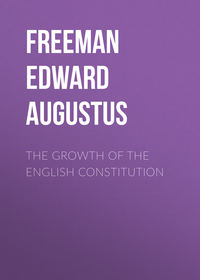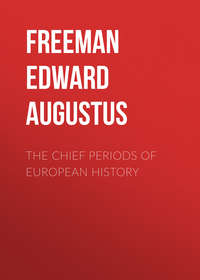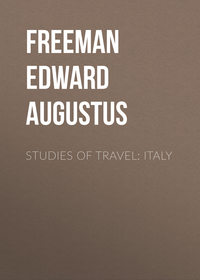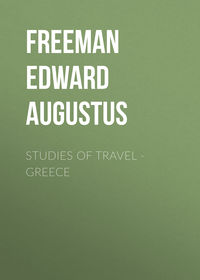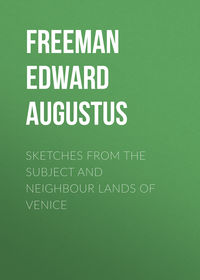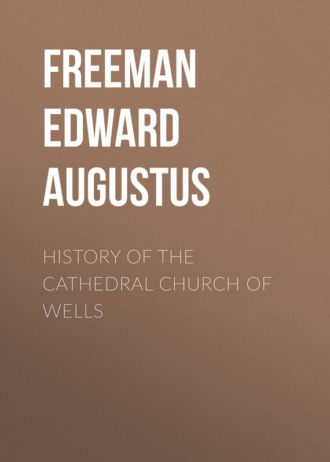 полная версия
полная версияHistory of the Cathedral Church of Wells
Bishop Robert, having thus settled himself as Bishop of Bath and Wells, with two churches under his special care, began to set to work to put in order whatever needed reform in both of them. He enlarged and finished the church of Bath, if he did not actually rebuild it from the ground. I speak thus doubtingly, because our accounts do not exactly agree. The little book called "Historiola de Primordiis Episcopatûs Somersetensis" says that "he himself caused the church of the Blessed Peter the Apostle at Bath to be built at a great cost."51 But the history commonly quoted as the Canon of Wells says only that "he finished the fabric of the church of Bath which had been begun by John of Tours."52 Now the "Historiola" is the earlier authority, and that which we should generally believe rather than the other, whenever there is any difference between the two. But, on the other hand, stories generally grow greater and not smaller; a man's exploits are much more likely to be made too much of by those who repeat the tale than to be made too little of. When therefore the later writer attributes to Robert less than the earlier one does, one is tempted to think that the earlier writer exaggerated or spoke in a loose way, and that the Canon of Wells had some good reason for his correction. And this is the more to be noticed, because we shall find exactly the same difference when we come to the accounts which the two writers give of what Robert did at Wells. It is indeed said that the church and city of Bath were again destroyed by fire in 1135, and that this made Robert's rebuilding necessary. But the phrase of being destroyed by fire is often used very laxly of cases where a building, like York Minster within the memory of some people, was simply a good deal damaged, and had to be repaired, but did not need to be wholly rebuilt. At any rate, whether Robert altogether rebuilt or only finished, the great church of Saint Peter at Bath was now brought to perfection. Do not for a moment think that this is the Abbey Church of Bath which is now standing, and which I do not doubt that a great many of you know very well. The church of John and Robert was of course built in the Romanesque style with round arches, and in that particular variety of Romanesque which had been imported by Eadward the Confessor from Normandy into England, and which we therefore call the Norman style. But the present church of Bath is one of the latest examples of our latest English Gothic, and of that special variety of it which forms the local Perpendicular style of Somersetshire. Moreover the Romanesque church was very much larger than the present one, which covers the site of its nave only. One little bit of the Romanesque building, the arch between the south aisle and the south transept, is still to be seen at the present east end. The fact is that the later Bishops of Bath and Wells were not at all of the same mind as John of Tours. They lived much more at Wells than at Bath, and took much more care of the church of Wells. Bath indeed was quite neglected, and by the end of the fifteenth century the church was in a great state of decay. It was then, in the year 1500, that Bishop Oliver King and Prior Bird began to build the present church on a smaller scale and in a widely different style of architecture. Besides what he did to the church, Bishop Robert built or rebuilt all the conventual buildings of his Abbey of Bath, the cloister, refectory, dormitory, and the rest, all which were necessary for the monks of Bath, though the secular priests of Wells could do without them.53
It is to be noticed that Bishop Robert, himself a monk, when he began to reconstitute the Church of Wells in the way of which I now have to speak, made no attempt to bring in monks instead of secular canons, or even to subject the Canons to the same half-monastic discipline which had been brought in by Gisa. All his changes in fact tended in an exactly opposite direction. Hitherto the Canons had been altogether dependent on the Bishop. They do not seem to have formed a distinct corporation, and the lands which they held, when they were not taken away from them altogether were held by them as the Bishop's tenants. All Robert's changes tended to give them greater distinctness and independence. The first business was to get back the lands which had been alienated by the connivance of Bishop John, and which Bishop Godfrey had in vain tried to get back. John the Archdeacon, we are told, repented on his death-bed, and straitly charged his brother Reginald to restore the lands. This he now did; he came to Bath and surrendered everything to the Bishop, but we shall presently see that his vested interest was thought worthy of some respect. It is now that we are told that, instead of the sixty shillings which John had paid each Canon yearly, the Bishop was able to pay them a hundred shillings.54 And now, to hinder anything of the kind happening again, Robert put the constitution and revenues of his Chapter on altogether a new footing. The Canons became a separate corporation, distinct from the Bishop; and, besides this, each Canon became for some purposes a separate corporation sole, distinct alike from the Bishop and from his brother Canons. For Robert first founded the dignities and prebends of the Church of Wells. The dignities are the chief offices of the Chapter, those of the Dean, the Precentor, the Chancellor, the Treasurer, and the Sub-Dean, all which offices still remain, to which we may add the Provostship, which still went on, and the Subchantership; these two no longer exist. Of these the Deanery and the Precentorship were certainly founded by Robert. Of the others I do not feel quite certain whether they were founded by Robert or by Jocelin.55 But in any case all that Jocelin did in this matter was to carry out the plans of Robert somewhat more fully, and we may fairly discuss the whole constitution as one work at this point. We need not suppose that all these offices were absolutely new; for instance, there must always have been a Precentor, or some one discharging the Precentor's duties in the immediate government of the choir. But at all events these offices were not till now distinct and permanent foundations, with a special status and distinct revenues of their own, which they now became. In the Dean especially the Canons now got for the first time a head of their own body distinct from the Bishop. Now as to the prebends. There is a corrupt way of speaking in use now of calling some few members of the Chapter Canons, as if the name belonged to them only, and calling the rest of the body Prebendaries, as if they were something different and, I suppose, something inferior. That this is a mere corruption is well known to every one who knows anything of the history of these foundations. But it is also made very plain by the language of official documents to this day. Whenever a new Prebendary is installed, he is still installed into "the Canonry or Prebend" of so and so; and when the whole Chapter is summoned for the election of a Bishop, all its members without distinction are still summoned by the title of Canons. The truth is that every member of the cathedral body is at once a Canon and a Prebendary. Canon and Prebendary are two different names for the same man looked at in two different characters. He is a Canon as one of the capitular body, a member of the corporation called the Dean and Chapter; he is also a Prebendary as holding – or of later years not holding – a certain prebend, præbenda, or separate estate, in regard to which he himself forms a corporation sole. The priests of Saint Andrew's had been Canons all along, but they first became Prebendaries under Bishop Robert. For it was he who first founded the prebends or separate estates. He divided the property of the Canons into two parts. Certain estates were to be held by the whole body in common as a corporation aggregate. Certain other estates were cut up into smaller portions or prebends, of which each Canon held one as a corporation sole. Such and such lands or tithes were attached as a prebend to the Deanery, to the Precentorship, and so on through the whole body; those Canons who did not hold any dignity, such as Dean or Precentor, being called Prebendaries of the place where their estates or corpses lay, Wormestor, Buckland, or any other. Some estates, as those of Combe and Wedmore, were so large as to form several prebends; thus we get the titles which sound so odd, Wedmore the first, Combe the twelfth, and the like. Thus each Canon came to have as it were two beings. As a Canon, he was one of a body, enjoying rights and discharging duties in common with his brethren. As a Prebendary he was independent, holding his own prebendal estate like any other holder of a benefice. But mark that the title of Canon, a title of office and duty, is clearly a more honourable title than that of Prebendary, which is a mere title of property. And mark again that, now that all the prebendal estates are transferred to the Ecclesiastical Commissioners, it may fairly be doubted whether there are any Prebendaries left, save the few who were appointed before those changes began. But there is nothing in the Act of Parliament which brought about those changes which at all touches the status of a non-residentiary Canon in any point except that of his property. What I want you to bear in mind is that, when a non-residentiary Canon becomes a Residentiary, he is not, as people commonly talk, changed from a Prebendary into a Canon. He was a Canon before, and, saving my own objection which I have just started, he remains a Prebendary afterwards. How the distinction between residentiary and non-residentiary Canons came about I shall explain presently.
The Church of Wells thus received a new constitution at the hands of Bishop Robert, who was helped in his undertaking by King Stephen and by his former patron, the King's brother Henry, Bishop of Winchester.56 This constitution is essentially the same as that which, in theory at least, exists still, and it is one which, in all its main features, is shared by Wells with all the other cathedral churches of the Old Foundation. The cathedral churches of the Old Foundation are those which have always had secular canons, which therefore were not suppressed at the dissolution of monasteries, but have gone on uninterruptedly with essentially the same constitution down to our own time. Such, besides our own church, are the neighbouring churches of Salisbury and Exeter. Such, in other parts of England, are York, London, Lincoln, Lichfield, Hereford, Chichester, and the four cathedrals of Wales. The churches of the New Foundation are those which in the time of Henry the Eighth were served by monks, which were therefore dissolved along with the other monasteries, and all of which, except Bath and Coventry, were refounded by him as Chapters of secular canons. Such was our old mother church of Winchester; such was the common mother church at Canterbury; such were Rochester, Norwich, Worcester, Durham, and the newer sees of Ely and Carlisle. With these are also reckoned the churches which became cathedral by Henry planting Bishops in them for the first time, Oxford, Peterborough, Saint Werburgh's at Chester, our own neighbours of Gloucester and Bristol, and Westminster, which lost its Bishop in the next reign, and is now only a collegiate church. And to these I suppose we must again add the churches of Ripon and Manchester, which have become cathedral in our own time. In all these the constitution is very different from that of the churches of the Old Foundation; among other things, they have not that variety of officers, each with his separate duties and revenues, which are to be found in the Old Foundations. And the influence of the Crown is much greater in the New Foundations than in the Old. Their Deans have always been appointed by the Crown, and in several of them the Canons also are appointed either by the Crown or by the Lord Chancellor. In the Old Foundations the Dignitaries and other Canons, except the Dean, have always been appointed by the Bishop. In the Welsh churches the Deans also have always been, and still are, appointed by the Bishops.57 In the others the Canons elected their own Dean, but a custom gradually came in by which the Crown recommended a person, who was always chosen. But within the reign of the present Queen, there chanced to be some legal objection to the person recommended by the Crown to the Chapter of Exeter, so that the Canons freely elected their own Dean, who held his place till his death; only meanwhile an Act of Parliament was passed, vesting in the Crown the appointment to the Old Deaneries as well as to the New. You will see easily that, though the connexion between the Bishop and his Chapter is everywhere much weakened from what it once was and from what it ought to be, it still is much closer in the churches of the Old Foundation than in those of the New.
It is to the wise and careful gradation of officers, each with his special function, in our own church and in the other churches of the Old Foundation, that I wish specially to call your attention. I assume of course that all are constantly resident, as constantly resident as a parish clergyman is on his living. I assume of course that none of them holds any preferment besides his cathedral office. These two conditions are necessary to the effective carrying out of the ancient scheme; it is owing to the breach of them, a breach which is no new thing, but which began almost from the beginning, that a most wisely and beautifully ordered system has gradually become a mere name. When offices whose duties require the constant presence of their holders on the spot are held by men who are resident for three months only or not resident at all; when there is not even any provision for the proper discharge of their duties by deputy, the whole scheme of those offices fails, and their mere empty titles become mockeries. The great offices of the cathedral, those of Dean, Precentor, Chancellor, and Treasurer, are sinecures in the legal sense, as being without cure of souls;58 but they were certainly not meant to be sinecures in any other sense. They are offices any one of which would afford ample occupation for a studious and thoughtful man, whose soul was in his work and who loved the institution of which he was a member. The Dean is the President of the Chapter, the general superintendent of the whole institution. I can say from the examples of men alike dead and living, that when that important post is held by a man who understands its duties, it is anything but a sinecure, anything but useless. A man of ability and zeal, to whom the cathedral and everything about it supplies some labour of love at every step, who knows and loves every stone of the fabric, whose heart answers to every note of its services, to whom every tittle of its history is a living thing, will not find the office of a Dean an idle or an irksome one. Unencumbered by any parochial charge, he will influence men's minds as the chief preacher of the cathedral church, and as continuing the old missionary functions of capitular bodies by preaching on fitting occasions in other parts of the diocese. As the chief presbyter of the city and diocese, he will be foremost in every good work within that city and diocese, ever at his post, keeping up order and discipline alike by precept and by example, dispensing the simple but liberal hospitality enjoined by ecclesiastical rule. As the President of the Bishop's Council, he will be the Bishop's right-hand man in his presence, and his most natural representative in his absence. Such I conceive to have been the sort of Dean whom good Bishop Robert wished to see at the head of his Chapter; such Deans there have been and still are, and under such Deans cathedral institutions are not found to be useless. Hardly less important are the functions of the officer second in rank, the Precentor. To his lot falls the immediate management of the cathedral services; he is, as Bishop Godwin says, "the Precentor to govern the choir."59 Here is work, full and worthy work, for an accomplished musician and profound liturgical scholar. It is plain that the duties of both these great officers are constant, that the presence of some one to discharge those duties is always needed. The pious care either of Robert or of Jocelin therefore provided for their occasional and unavoidable absence, by the foundation of two officers, holding the rank of dignitaries, whose duty it was to supply their place on such occasions, namely, the Sub-Dean and the Sub-Chanter. The office of Sub-Chanter no longer exists; the Sub-Dean, I need not say, is still among us. Next comes the Chancellor, the Chancellor of the Church, whom I hope no one will confound with the Chancellor of the Diocese, a judicial functionary with whom my history has nothing to do. His business, says Godwin, is "to instruct the younger sort of Canons." But his business is more than this: he is the great educational officer of the church and diocese; the head and centre of all that is done in that way in the city and diocese. Here, I need not say, is practical work enough for any man, especially in these days. One very natural part of his functions is now very efficiently discharged among us, but it is discharged by other members of the capitular body, and by them hardly in their capitular character.60 The last of these great officers is the Treasurer, who must not be taken for a bursar or steward; his duty is to "look to the ornaments of the church." His duties are certainly less wide and less important than those of his brethren: but they are duties which to an ecclesiastical antiquary would be a labour of love; and, if they were combined with the special care of the church itself, with the office of Master of the Fabric, they would rise in importance to a level with any of the others. Such were the dignitaries, each, besides his share of the general revenue, having his own special prebendal estate. Such was the case with the other Canons also, the whole body amounting in Robert's time to about twenty-two. Other Bishops increased their numbers till they reached the full tale of fifty, at which they still remain.
In what I have just been saying, I have been drawing an ideal picture, a picture of the great officers of a cathedral body, as they ought to be, as I doubt not that their founders meant them to be, but not as I suppose that they ever will be, or that they ever were. But in this, as in all other matters, it is well to make our ideal the highest possible. If we aim at the highest mark, we shall, in this imperfect world, most likely not hit it, but we shall assuredly come much nearer to it than if we are content to aim at a lower mark. What hindered this goodly scheme from being carried out for any length of time, what probably hindered it from being ever in its fulness carried out at all, was the vice of the age, the inveterate tendency to pluralities and non-residence. In fairness to our own age we must say that the instances of those abuses which still remain, even those which remained in the last generation, are trifles compared with the pluralities and non-residence of the Middle Ages. But in fairness to those ages we must also say that the pluralities and non-residence of those days had not always their root in mere unscrupulous greediness, but in a peculiar view of ecclesiastical offices, which we now hold to be wrong, but which the circumstances of those times rendered natural. The true theory of the endowment of an ecclesiastical office doubtless is that an office is instituted for the common good; it is the business of its holder to discharge its duties in person; an endowment is attached to it, not as mere payment for work done, but as a maintenance for its holder and a means of enabling him to discharge his duties efficiently and liberally. But the feudal notions which were then prevalent caused ecclesiastical offices to be looked on in quite another light. Temporal estates, temporal benefices– for the word is just as correctly applied to a lay fee as to a bishoprick or a rectory61– were held of the lord by the tenure of performing some service, military or otherwise, for the lord's behoof. So that those services were efficiently performed, it was not necessary, it was not always possible, that the holder of the fief should perform them in his own person. And of course there has been no time when temporal men have had any scruple, nor is there any reason why they should have any scruple, in multiplying their temporal estates as largely as they honestly can. A false analogy led men to look on ecclesiastical offices in the same feudal light. They were looked on as benefices rather than as offices, as estates held by a certain service, by the discharge of certain ecclesiastical duties, but, provided those duties were performed, it was thought to matter little whether the holder of the benefice performed them personally or by deputy. Here and there a specially virtuous man, a saint in short, would not cumber himself with any office whose duties he could not perform in his own person. But men of ordinary virtue, men who were not scrupulous beyond the public opinion of their day, did not hesitate to heap benefice upon benefice, and thought their consciences were perfectly clear if the duties of each were discharged by a competent deputy. It is like any other evil fashion; we admire those who rise above it; we are not hard on those who conform to it, provided they do not sink before the received morality of the time. But the prevalence of this view of ecclesiastical property was enough to undermine from the very beginning all such pious schemes as those of our Bishop Robert. And we find that Robert was himself driven to a course which was probably unavoidable, but which reads very like a compromise, not to say a job. We have seen that Reginald the brother of Archdeacon John restored the capitular estate. But we find that Robert invested Reginald with the office of Precentor, and, what is more, attached to it as its prebend the whole estate of Combe, an estate so valuable that it was provided that on Reginald's death it should be divided into five prebends.62 Possibly Reginald did not personally lose much by surrendering the estate of the Canons, when his prebend, like Benjamin's mess, was five times as much as any of theirs. And it is further to be noticed that two nephews of Reginald, two knights called Payne of Pembridge and Roger Witing, did not willingly acquiesce in an arrangement which cut them off from the succession to what they had learned to look on as an hereditary estate. In the reign of Henry the Second they brought an action to recover the lands which had been restored to the Church by their uncle Reginald. It is said in a marked way that this happened after the death of Stephen and the accession of Henry. This looks therefore as if Henry had some ill-feeling against a Bishop who had been so specially favoured by his mother's rival. It sounds very strange to read that, though the claim of the two knights was strongly withstood by the Bishop, by Ivo the first Dean, and by their own uncle Reginald, now Precentor, yet in the end the matter had to be compromised, and the claims of Reginald's nephews were bought off with a payment of twenty marks.63 This case is only one of many in which the Church found it very hard to recover lands of which it had once parted with the possession, whether in the usual form of a lease for three lives – a very old custom indeed64– or of any other. We have no statement from the side of Reginald's nephews, and it is quite possible that their case may really have been not unlike that of those who in our own day have enfranchised lands held of ecclesiastical bodies. In any case the name of one of the claimants is worth notice, and local genealogists may perhaps be able to tell me something about his descendants. It would be remarkable indeed if Roger Witing, the obstinate enemy of the Church of Wells, should prove to have been a forefather of Richard Whiting, the Abbot and martyr of Glastonbury.
In the deed by which Bishop Robert founds the Deanery and Precentorship, he distinctly says that his object is to secure the Canons against such spoliations as they had suffered at the hands of the Provosts.65 This object, there can be no doubt, was effectually compassed. When part of the estates of the church was held by the Canons in common, while each Canon held another portion as his own separate endowment, it is clear that they could no longer lie at the mercy of any one officer. He also founded an admirable system of offices in his church, which, if fully carried out, would greatly improve its discipline within and greatly extend its usefulness without. But there can be no doubt that his changes had indirectly, and certainly undesignedly, another effect of which we cannot so fully approve, the effect of weakening the old connexion between the Bishop and his cathedral church. We must remember that a spirit of corporate isolation was the spirit of the times. Liberty, as has been well said, meant privilege. Every body of men, ecclesiastical or civil, strove rather for its own independence than for the well-being of the whole country. Every town, district, monastery, university, ecclesiastical body of any kind, did all it could to procure exemptions of one kind or another, to withdraw itself from the general and ordinary jurisdiction and to set up some exceptional jurisdiction of its own. Traces of this system linger here and there, wherever there is a temporal jurisdiction different from the jurisdiction of the ordinary Judges and magistrates, wherever there is an ecclesiastical jurisdiction different from that of the Archbishop, the Bishop, and their regular officers. I am far from saying that the working of this system has been altogether bad. In many cases it has been conspicuously good. For it was simply by one application of this system that the boroughs of England each, one by one, wrested or bought their independence from their temporal or spiritual lords. But it illustrates the difference between those times and ours that the original independence of those boroughs was won by a series of isolated local struggles, while their reform in our days was wrought by a single Act of Parliament for the whole country. The spirit of local and corporate independence was the natural, and in many cases the beneficial, result of the circumstances of the time. But it had its weak side, especially in ecclesiastical matters. The monasteries set the example in obtaining exemptions from the jurisdiction of the Bishop of the diocese. Other ecclesiastical corporations followed them. Each cathedral Chapter now became a distinct corporation, with a head, in the person of its Dean, distinct from the Bishop. I suspect that the institution of the Deanery, more than any of the other changes, tended to weaken the tie between Bishop and his Chapter. Hitherto the Bishop had been the head of his Canons, much as an Abbot was the head of his monks. Now the Chapter became a separate body, with interests and possessions of its own distinct from those of the Bishop. It had a head of its own, who must have been strongly tempted to set himself up as a rival of the Bishop. The old tie was gradually loosened; the Bishop, from being the immediate head of his cathedral, sank into the mere Visitor of an independent corporation, having less authority in his own church than in any other church in the diocese. It became a point of honour with capitular bodies to lay more stress on maintaining their chartered rights against the Bishop than on working with the Bishop to promote the ends for which both Bishops and Chapters were founded. The Bishop and his Chapter became alike isolated. Two authorities which were intended to work together very much like a King and his Parliament, silently divided the departments of administration between them. The Bishop came to manage the affairs of the diocese without any reference to the advice of his nominal Council the Chapter. The Chapter came to manage the affairs of the cathedral with very little reference to the authority of the Bishop. Instead of an immediate ruler, he became an external power, called in ever and anon to reform an abuse or to settle a dispute. It gradually came, in most places at least, to be held in law that the freehold of the cathedral church was vested in the Dean and Chapter or Prior and Convent. The old theory that, when the cathedral was served by monks, the Bishop was their Abbot, had thus quite died away. At the dissolution of religious houses, the monastic cathedrals were surrendered by their Priors and Convents, just like the other monasteries. The metropolitan church of England became the property of Henry the Eighth, and he had the right in law, not only, as he did, to despoil it of all its treasures, but to destroy, dismantle, or desecrate the fabric itself, as was actually done with the churches of Bath and Coventry. The Bishop of Coventry and Lichfield earnestly prayed that his head church might be spared, but the tyrant was not to be moved, and in law, as law had gradually come to be understood, no right of the Bishop was touched by its destruction.66


